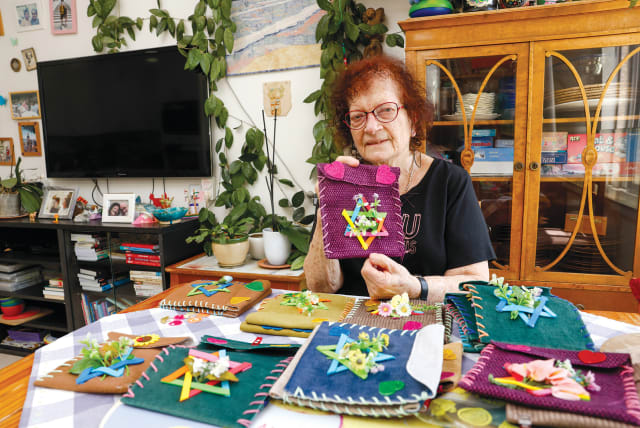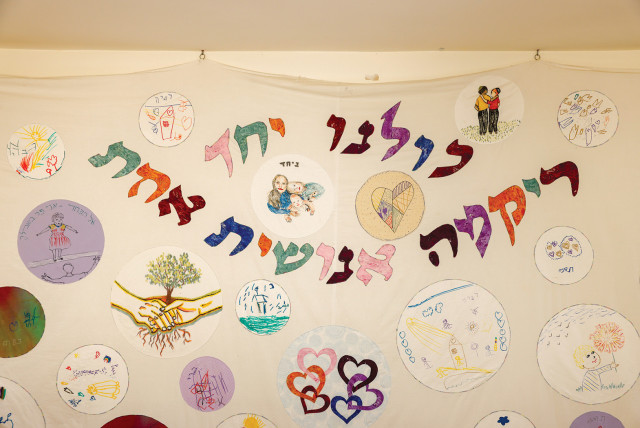Life's a Patchwork: How art and working with children enrich one woman's life

Mira Furth found fulfillment by channeling her skills to teach youngsters about art… and life

Mira Furth, an energetic and cheerful 80-year-old who lives in the Bayit Balev Jerusalem retirement residence across the street from Sacher Park, spends much of her free time working with the children of the two kindergarten classes that meet in the Bayit Balev building, ranging in age from four and a half to six years old, developing arts and crafts projects.
On a warm June Jerusalem morning that presaged the hot summer weather on its way, I met with Furth, who recounted her life experiences and how art and working with children have enriched her life immeasurably. As we drink coffee in the lobby, the woman in charge of the coffee bar exclaims, “There is nothing like this woman. You will not find anyone like her!”
Furth was born in Jerusalem, served in the IDF in the early 1960s, and lived in Kibbutz Mahanayim for a decade before returning to the capital. She met her future husband at work and married in 1985. Furth, together with her husband and daughter, moved to Ma’aleh Adumim, spending most of her career working in the computing unit of the State Revenue Department, when computers were operated by punch cards and later by terminals. She retired in 2004.
“My mother didn’t understand what I did,” she recalls, smiling. “The work was unusual and interesting, and I was successful.”
Furth never considered herself artistically gifted. It was only after retirement that she began taking classes in patchwork and quilting, and found within herself a heretofore hidden talent. Patchwork consists of sewing many pieces of fabric or leather together to create an attractive pattern or design; quilting refers to joining two layers of fabric together with an inner layer to make blankets.
“Once I retired and began to design patchwork, I was very happy,” she recalls.
Furth began making gifts for family and friends, including decorative towels, blankets, and other colorful and creative projects. “Creating is one of the best ways to enjoy life and gain self-confidence,” she says. “When you make something, you are not passive – you have something, and you are alive. If you don’t do anything, it is as if you don’t exist because you would not be leaving something of yourself.
“I learned this only after I had retired. I had never considered it before.”
She moved to the Bayit Balev retirement residence in Jerusalem in 2016 with her husband, Aryeh, when he became ill with Alzheimer’s disease. After several years, he was unable to remain there; today, he is in a geriatric residence near Rehovot, where her daughter lives with her family.
“Aryeh’s whole situation was very difficult for me,” she says, “When I had to make the decision to transfer him to a geriatric institution, it was very difficult, and carrying it out was even more so.” Despite the urgings of the social worker, Furth did not join in the kindergarten’s activities initially. She was simply too depressed.
She recalls the first time she participated in a joint activity with the children. “I have to give credit to the social worker we had at the time. She would say to me, ‘Come, Mira,’ but I didn’t want to join them.”
Finally, two years ago, at the end of the school year, Furth agreed to join a trip with 10 residents of Bayit Balev who accompanied the children and kindergarten staff to the Ein Hemed nature reserve, 7 km. west of Jerusalem.
Beaming, Furth says, “It was wonderful.” The children foraged for small pieces of wood, and the seniors helped them make them into tiny boats, which the youngsters then launched into the water. Recalling her own childhood, she says with a grin, “They didn’t do these kinds of things when I was in kindergarten.”
Recalling the event in Ein Hemed, Sara Salomon, who teaches the special education students in the kindergarten, says, “When Mira went with us to Ein Hemed, it was magic. She fell in love with us, and we fell in love with her.
“When she saw the children, something opened up within her. She connected with the children, and she flourished.
“Mira is really an essential part of the kindergarten today. She brings new ideas and has motivation. She is the most creative woman I have ever met.”
Furth’s talents extend far beyond the technical skills of sewing threads and choosing fabrics. She has exhibited an uncommon ability to interact with the 29 children in the Bayit Balev kindergarten, exhibiting uncommon amounts of patience, love, and kindness. Salomon adds that beyond her artistic skills and imagination, she has a unique ability to relate to the children, even those not naturally inclined to art.
“It is amazing to see how thrilled she is when she succeeds with a child,” notes Dvora Nachum, who works with the other students in the kindergarten and agrees wholeheartedly with Salomon’s assessment.
Encouraged by how the children had taken to Furth on the trip to Ein Hemed, the kindergarten teachers asked her to design a decoration for their end-of-the-year ceremony. Furth chose the theme, which was “We are one fabric of humanity.”
She cut circles out of cloth – “circles are the best because they are complete, and the most beautiful form –” and Bayit Balev residents and the children in the kindergarten designed pictures on the circles focusing on the theme.
She attached the designs to a large piece of fabric, and the resulting banner was used at the kindergarten’s concluding event. Following the event, the sign was moved inside Bayit Balev and is now prominently displayed in its lobby.
Ongoing project, ongoing connection
After the project’s success, Furth made helping the youngsters in the kindergarten a part of her regular activities and visits there once a week, initiating arts and crafts projects and patiently helping them. Throughout the year, she created holiday greeting card projects for the children for Rosh Hashanah, Sukkot, Purim, Passover, and Independence Day.
This year, for Passover, she had the children design a spring theme on a special tray to hold matzot. “I explained to the children about spring and what it means,” she recalls. “I tried to communicate the idea of aesthetics. I wanted butterflies and flowers.
“More and more children came to the table, and they sat and drew. It was a pleasure to see. We were amazed. It really moved me. It was a connection deeper than words.”
The children’s designs were printed on the matzah stands through a special process, and the children brought them to their family Seders.
Furth was assisted in the Passover project by Rabbi David Geffen, a resident of Bayit Balev and longtime contributor to this magazine and The Jerusalem Report. Salomon observes that the children enjoy a marvelous relationship with Geffen.
“He is always thinking about the children and the connections that he can make with the Bayit Balev residents, and what he can give to the children,” she says. In turn, the children have affectionately given him the title of Saba David (Grandpa David). Furth is called Savta Mira (Grandma Mira) by the youngsters.
The events of Oct. 7 and the Israel-Hamas war that has ensued over the past eight months have not left Bayit Balev unscathed. The grandson of a resident was killed on the first day of the war, and the son-in-law of the home’s social worker was killed. Many fathers and relatives of children in the kindergarten have been serving in the IDF over the past several months. Salomon says that the children hear reports of what is happening from relatives and are exposed to what is happening. Ultimately, it is the kindergarten that provides them with a sense of security.
“It is our job as kindergarten teachers to make it a safe place,” she says.
Shortly after the war started, one kindergarten teacher brought Furth pieces of brown cloth and asked what she thought could be done with it for an art project. Says Furth, “It reminded me of the sackcloth from stories of mourning from the Bible, or even of the yellow patch that Jews in German-occupied Europe were forced to wear.” She was determined to come up with something more upbeat.
Using some leather remnants from another Bayit Balev resident, she assembled a small, attractive shoulder bag with a strap that the children could wear. She then attached additional material to the bag to form a Star of David, expressing Israel’s national symbol, and topping it off with flowers, giving it a whimsical and more optimistic bent.
She showed her sample to the teachers, who were duly impressed, and they suggested that it be used as the students’ end-of-the-year project, since she would have to work with each child individually.
In recent weeks, Furth has been visiting the kindergarten several times a week to ensure that all of the children finish their shoulder bag projects before kindergarten ends for the year. She has been using remnants of material donated by furniture stores to make the bags. For his part, Geffen has been arranging outside funding for the children’s project, and each bag will be presented to the students with a small book inside for their enjoyment.
Furth is pleased with her shoulder bag project and calls it “my solution for the war.” In the meantime, she is planning more projects for her kindergarten students next year and hopes to create a new wall hanging for the Bayit Balev lobby to replace the one she made two years ago.
Sitting in her ninth-floor apartment in Bayit Balev overlooking Sacher Park, Furth shows me samples of the shoulder bags that she created. While her dwelling is not particularly spacious, she has efficiently used every meter for her hobbies.
Immediately behind the table in the living room is a small niche with a computer and printer. She gets ideas and inspiration online from sites such as Pinterest. Adjacent to her bed, she has made another work area complete with a sewing machine, where she does a great deal of her quilting and patchwork projects.
She still attends patchwork workshops, driving weekly to sessions in Mevaseret Zion. Samples of her patchwork projects adorn the wall, including a particularly attractive design of Hof Habonim, which she made from a photo she had taken.
Salomon says that the connections and relationships created when children and senior adults, as in the case of Bayit B’alev, are essential for both groups. “These connections provide life and vitality to the senior residents and instill the children with important values. The children learn to accommodate, and they learn patience through the slower pace of the seniors. They learn to become interested in their stories and life experiences,” she says.
Furth acknowledges that it is not uncommon for children to be apprehensive and afraid of being around older adults. “Here, they are not afraid,” she says. On the other hand, she points out that sometimes, older people are afraid of being around children. Recently, she says, a woman who had never wanted to accompany her to the kindergarten decided that she wanted to join her one morning.
Chuckling, she says, “I thought she was coming to help me, but she just wanted to draw with the children. When she finished, she said to me, ‘I don’t know what to tell you, but the atmosphere around the table with the children was so pleasant and filled with laughter.’”
Summing up, Furth says, “My work in the kindergarten is win-win. I enjoy it so much, and they enjoy it.”■
Jerusalem Post Store
`; document.getElementById("linkPremium").innerHTML = cont; var divWithLink = document.getElementById("premium-link"); if (divWithLink !== null && divWithLink !== 'undefined') { divWithLink.style.border = "solid 1px #cb0f3e"; divWithLink.style.textAlign = "center"; divWithLink.style.marginBottom = "15px"; divWithLink.style.marginTop = "15px"; divWithLink.style.width = "100%"; divWithLink.style.backgroundColor = "#122952"; divWithLink.style.color = "#ffffff"; divWithLink.style.lineHeight = "1.5"; } } (function (v, i) { });

